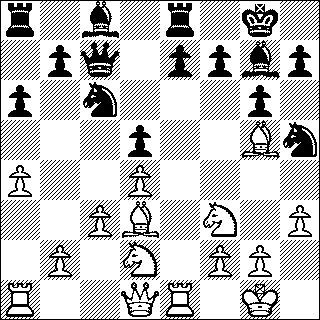[Event "USCF/WS/07WM41"]
[Site "ICCF"]
[Date "2007.10.6"]
[Round "-"]
[White "Hoffmann, Joe"]
[Black "Owens, Steve"]
[Result "0-1"]
[WhiteElo "1643"]
[BlackElo "1575"]
1. e4 c6 2. d4 d5 3. exd5

Oh, Goody! The Exchange Variation. White players of 1.e4 will often choose the Exchange as it appears to be easier to assimilate than the Panov, Classical, or Advance variations.
To a CK player like me, the Exchange is candy that achieves our goals of attaining equality with an equal share of the center.
3... cxd5 4. Bd3 Nc6 5. c3 g6 6. Nf3 Bg7 7. O-O Nf6 8. Re1 O-O

Let's look at the position:
Black's pieces are very actively placed. Black has an equal share of the center. The Black King is safely ensconced behind a fianchettoed Bishop and the best defender of any King's Position, the Knight on KB3 (f6). White is castled and his rook developed to e1. He also has a Knight on KB3 (f3). His King Bishop is nicely placed at d3.
Looking deeper, this position plays like a Queen Pawn opening. In such openings, the advance/exchange of the c pawns often determine the outcome of the game. Black has traded his for the White e pawn and has the complete use of the c file. The White c pawn, however, is retarded and may not advance without weakening White's position. In this variation, White has transposed to a QP opening and has solved Black's largest dilemma, that is, how and when to get in P-QB4 (c5).
9. h3 Qc7 10. Bg5 Re8 11. Nbd2
Na3 is an alternate. Bobotsov - Arlamowski (Miedzyzdroje - 1952) continued 11.Na3 a6 12.Qd2 Bd7 13.Re2 Rad8 14.Rae1 Qc8 15.Nc2 b5 16.Ne5 Nxe5 17.dxe5 Ne4 18.Bxe4 dxe4 19.Rxe4 Bxh3 20.Nd4 Be6 21.a3 Qb8 22.Qe2 Bd5 23.Re3 Bc4 24.Qg4 Qc8 25.Qh4 Qc7 26.g4 Rd5 27.f4 Rxd4 28.cxd4 Qd7 29.d5 Bxd5 30.Rh3 h6 31.Bxh6 Bxh6 32.Qxh6 Qxg4+ 33.Kf2 Qg2+ 34.Ke3 Qe4+ 35.Kd2 Qd4+ 36.Kc1 Qc4+ 37.Rc3 Qa2 38.Qh4 a5 39.f5 b4 40.fxg6 fxg6 41.axb4 Qa1+ 42.Kc2 Qa4+ 43.Kd2 Qxb4 44.Qxb4 axb4 45.Rc5 Rd8 46.Ke3 Kf7 47.Rb5 b3 48.Rd1 Ke6 49.Rxb3 Kxe5 50.Rb6 Rg8 51.b4 e6 52.b5 g5 53.Kf2 Rc8 54.Rb1 Rc2+ 55.Ke3 g4 56.Rb8 Rc4 57.b6 g3 58.Rg8 Re4+ 59.Kd2 Rd4+ 60.Ke1 Re4+ 61.Kf1 Rf4+ 62.Kg1 g2 63.Rh8 Rf7 64.Rh5+ Kd6 65.Rh8 Rb7 66.Rd8+ Kc6 67.Rc8+ Kd6 68.Rcc1 Rf7 1/2-1/2
http://www.chessgames.com/perl/nph-chesspgn?text=1&gid=1310314
11... a6 12. a4 Nh5
This little dance by the Knight is in response to the vulnerability on e8 and a small threat to take f4 as an outpost with the attendant pressure on the White squares and Queen Bishop.

13. Be2 Nf6
I thought hard about 13...Nf4 but decided I was not ready to attack at that moment.
14. Bd3 Nh5
Ok! I don't think he had a definitive plan with Be2.
15. Bh4 Bd7 16. Nf1 e5

It was now or never for an e5 break.
17. dxe5 Nxe5 18. Nxe5
18.Ne3 Nf4 might have been an alternate continuation.
18... Rxe5
Taking with the Queen is more flexible.
19. Rxe5 Qxe5 20. Bg3 Nxg3

This is the result of leaving the Bishop on g5-h4 instead of retreating to e3 around move 13 or 14. Black now has the two bishops and plenty of diagonals to open and exploit.
21. Nxg3
Another look at the position:
Black's pieces are very well placed and active. The Queen is centered and dominates the board. The Isolated Queen Pawn is not a liability and can advance readily. White's Rook needs to get to the e or d file but the Queen blocks him. White should remedy that now, but instead...
21... Bc6 22. Rc1? d4!
This helps further Black's pursuit of taking the center of the board. With White's Knight removed toward the rim as a result of the exchange on g3 and Black's possession of the two bishops, Black's Queen has an almost unbreakable hold on the central position. The Black Rook is poised to add his weight to that hold.
23. cxd4 Qxd4 24. b3 Rd8 25. Be2 Qh4

Why exchange Queens when an attack on the King can be glimpsed, the Rook can take control of the d file, and the King Bishop can seize d4 and put more pressure on f2?
26. Qf1 Bd4 27. Rd1 Rd6
f6 is the Rook's destination.
28. Rd3 Rf6 29. Nh1

Once again taking stock of the position. White does have his Rook on a central file, but it is totally defensive. His Queen and Knight have retreated all the way back to defend f2. His Bishop can only look on while the action is on the opposite color.
29... h5
To remove the Bishop's one useful outpost to combine with Bb6.
30. Bg4 Bb6
The Bishop must vacate immediately.
31. Bd7 Be4
No Trades.
32. Rd2 Qf4 33. Re2 Rd6 34. Qe1
Perhaps 34.a5 could have been tried to disrupt the b6 Bishop.
34... f5 35. Be8 Bd4 36. a5 h4
0-1

White Resigns. The Black pieces have complete control of the board. Of the four center squares, Black pieces sit on two and the other two pieces control and influence all four. White's pieces are relegated to the board rims, with only White's Rook off of the edge, and only by one file. The Knight is banished to the corner on h1.
The two bishops, pinning pawns and pieces around the King, have visions of mating nets swimming in Black's dreams while causing horrific nightmares for White's King.
The continuation will be 37.Ba4 Be5 38.g3 Qf3 39.Rxe4 fxe4.

